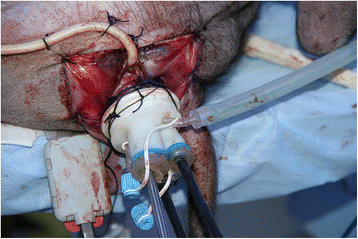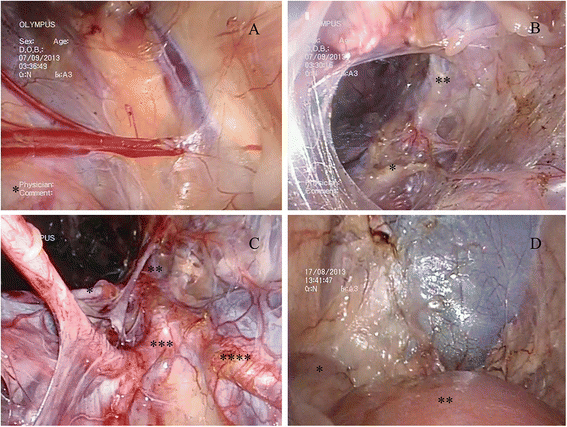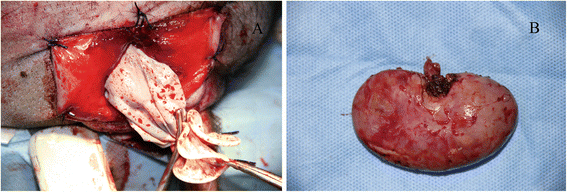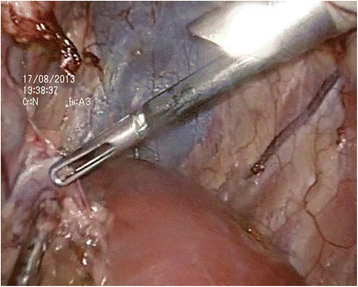Pure retroperitoneal natural orifice translumenal endoscopic surgery (NOTES) transvaginal nephrectomy using standard laparoscopic instruments: a safety and feasibility study in a porcine model
- PMID: 27286863
- PMCID: PMC4902946
- DOI: 10.1186/s12894-016-0145-7
Pure retroperitoneal natural orifice translumenal endoscopic surgery (NOTES) transvaginal nephrectomy using standard laparoscopic instruments: a safety and feasibility study in a porcine model
Abstract
Background: Among the different organs used for NOTES (natural orifice translumenal endoscopic surgery) technique, the transvaginal approach may be the optimal choice because of a simple and secure closure of colpotomy site. Pure and hybrid NOTES transvaginal operations were routinely performed via transperitoneal access. In this study, we investigate the safety and feasibility of pure retroperitoneal natural orifice translumenal endoscopic surgery (NOTES) transvaginal nephrectomy using conventional laparoscopic techniques in a porcine model.
Methods: Six female pigs, weighing an average of 30 kg, were used in this study. Under general anesthesia, pure retroperitoneal NOTES transvaginal nephrectomy was conducted using standard laparoscopic instruments. Posterolateral colpotomy was performed, and the incision was enlarged laterally using blunt dissection and pneumatic dilation. A single-port device was inserted to construct the operative channel. The retroperitoneal space was created using sharp and blunt dissection under endoscopic guidance up to the level of the kidney. Dissection and removal of the kidney were performed according to standard surgical procedure, and the colpotomy site was closed using interrupted sutures. The survival and complications were observed 1 week postoperatively.
Results: Our results showed that two cases failed because of peritoneal rupture. One case was successful, but required the assistance of an extra 5 mm laparoscopic trocar inserted in the flank. Three cases of pure retroperitoneal NOTES transvaginal nephrectomy were completed, and survived 1 week after the operation. In these three cases, no intra- or postoperative complications were observed.
Conclusions: All findings confirmed the safety and feasibility of the retroperitoneal pure retroperitoneal NOTES transvaginal nephrectomy using standard laparoscopic instruments, which suggested the possibility of clinical application in human beings in the future.
Keywords: Animal; Natural orifice translumenal endoscopic surgery/method; Nephrectomy; Retroperitoneal space; Transvaginal surgery; models.
Figures





Similar articles
-
Transvaginal Natural Orifice Transluminal Endoscopic Nephrectomy in a Series of 63 Cases: Stepwise Transition From Hybrid to Pure NOTES.Eur Urol. 2015 Aug;68(2):302-10. doi: 10.1016/j.eururo.2015.03.033. Epub 2015 Mar 31. Eur Urol. 2015. PMID: 25837534
-
Robotic retroperitoneal transvaginal natural orifice translumenal endoscopic surgery (NOTES) nephrectomy: feasibility study in a cadaver model.Urology. 2013 Jun;81(6):1232-7. doi: 10.1016/j.urology.2012.11.083. Epub 2013 Mar 27. Urology. 2013. PMID: 23541230
-
Feasibility of right and left transvaginal retroperitoneal nephrectomy: from the porcine to the cadaver model.J Endourol. 2009 Nov;23(11):1887-92. doi: 10.1089/end.2008.0682. J Endourol. 2009. PMID: 19839748
-
Laparoendoscopic single-site and transvaginal nephrectomy.Minerva Urol Nefrol. 2011 Jun;63(2):169-74. Minerva Urol Nefrol. 2011. PMID: 21623334 Review.
-
Surgery via natural orifices in human beings: yesterday, today, tomorrow.Am J Surg. 2012 Jul;204(1):93-102. doi: 10.1016/j.amjsurg.2011.05.019. Epub 2011 Dec 28. Am J Surg. 2012. PMID: 22206853 Review.
References
MeSH terms
LinkOut - more resources
Full Text Sources
Other Literature Sources

